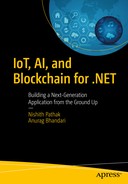In last decade, we have seen the emergence of various computer technologies, each of which was disrupting and revolutionary. Some of these technologies paved the way for a newer generation of technologies to make our lives easier. Some of these technologies are in the category of invention, as they change and disrupt the entire ecosystem. There was a big wave that produced a lot of new billionaires and millionaires. What was available for just 2 cents in 2009 is now available for more than $15,000 US. Yes, we are talking about Bitcoin and Blockchain. Blockchain is the technology behind Bitcoin. Cryptocurrency and especially Bitcoin have certainly divided the world into two zones—one that supports cryptocurrency and the other that opposes it. The use of cryptocurrency has been such a craze that there are around 1400+ cryptocurrencies like Bitcoin in the market, having more than 17+ million accounts. People have raised doubts about the future of Bitcoin. A few countries don’t allow cryptocurrencies in their economies, but almost all of them have provided tremendous support for Blockchain. Bitcoin is just one of the finest implementations of Blockchain, but Blockchain is certainly going to stay and is currently transforming the way we trust across work and business.
Until this point, we have assumed the role of intermediaries to be important. They are part of our core ecosystem of daily life. Everything that we do, such as buying vegetables or buying a house, getting an insurance claim, signing a contract, or even booking a hotel destination for our upcoming vacation, includes intermediaries. Apart from bringing a few advantages, it also brings several disadvantages, like cost, lack of transparency, and brokerage percentages. Wouldn’t it be great if we had a technology that reduced all intermediaries? Wouldn’t it benefit the producer and the consumer? Yes, this technology has arrived and it’s called Blockchain. Bitcoin and the rise of cryptocurrency is possible with the technology behind it, which we call Blockchain. Blockchain and Bitcoin are so interrelated that a lot of times people use these terms interchangeably. Well before we go further and drill down more in detail, let’s understand how Blockchain is not Bitcoin.
History of the exchange medium
Need and emergence of Bitcoin
What Blockchain is
How Blockchain is different from Bitcoin
Features of Blockchain
Various types of Blockchain
Blockchain will change the way we trust. It is important for you to understand the core reason for creating a technology like Blockchain. Hence, it is important to understand the history behind cryptocurrency, as it will help you understand the underpinnings for creating a technology like Blockchain.
The History of Cryptocurrency
Since the evolution of mankind, there has been various types of exchanges, each of which has pros and cons. Back in 6,000 BC, it all started with the barter system. The barter system is about trading services and goods. It was definitely a good system—a person was required to produce or offer services that he is specialists in and then exchange those for the goods that he/she requires. The barter system continued successfully for centuries but had a few fundamental flaws including the absence of a common unit of value for exchange. This results in creating a different valuation for the different exchange of good. For example, buying a few apples in exchange of a liter of milk might be good, but the same liter of milk might not be traded for rice. It requires a new valuation, which may or may not be accepted by all parties involved. Apart from this, few of the goods were perishable in nature and few goods were large and heavy, making them transport-unfriendly. Another flaw with the barter system was proof of ownership. There was no way to tie goods to a person. These flaws led to the emergence of the gold coins era.
Era of Gold Coins
The era of gold coins started around 650 BC. The use of coins resolved some of the basic and fundamental problems with the barter system. For example, gold coins serve as a common unit of value. Now a certain number of goods could be exchanged with a gold coin. Gold is also non-perishable in nature and can be easily transportable. Gold coins also have a couple of flaws, primarily that they are expensive and insecure. Anyone can easily steal gold coins. Moreover, it was not easy to mine gold. All of these issues led to paper-based currency, aka FIAT currency.
FIAT Currency
The paper currency era started around 960 AD. During the initial days of paper currency, people deposited gold coins to third-party financial corporations. Some of these financial parties are now called banks. In lieu of gold coins, these third party gave IOU notes, which were treated as standard currency notes. These IOU notes were also termed the first form of FIAT currency.
Tip
FIAT currency is the standard currency being supported by government regulations and institution. Currencies like the Dollar, Yen, Rupee, Euro, Pound, etc., are current FIAT currencies. We use FIAT currency terminology later in the due course of the chapter.

Some of the currently used FIAT currencies
In spite of paper currency being successful and used currently as well, it has its flaws. FAIT currency is unsecured, inflationary, and untraceable. There is no way you can tie paper currency to a person. Anyone can steal your currency and use it again. Government institutions backing currency have no way of knowing who owns the currency. Once the currency is in the market, there is absolutely no way to trace it. This can create a lot of inflation in the market, leading to economic issues like black money hoarding and parallel economies. Some of the countries also use demonetization drives to replace the running currency with new currency notes to stop creating parallel economy.
Using Checks

A sample check from a checkbook , where the user is filling in the receiver’s info
However, checks also have a few issues, especially transaction verification time. Consider a normal case, when a buyer needs a good and he issues a check in lieu of getting those goods. The buyer gets the good but the seller now has to verify the authenticity of the check only when the seller’s bank talks with the buyer bank and gets the clearance of debt. Currently, check clearance takes from 1-4 working days. There are chances that the check is fraudulent and in practical scenarios, the seller now needs to chase the buyer. Checks also have a very basic version of cryptography, via the signature, but that can easily be forged.
Promises of E-Wallet
With so many flaws with FIAT currencies and checks, there was a need to create a new medium of exchange, based on which e-wallet was introduced. E-wallet is almost a perfect medium of exchange. There is no need for paper currencies and you don’t need to carry a wallet with you. It is fast, convenient, and efficient, with transaction verification happening in a couple of seconds. This solves the biggest issues with checks. It can easily be installed and accessed from any device, including mobile devices. By using various mobile biometric and IRIS security measures, the validating transaction can reach the highest level of security compared to using signatures on checks. As there is no paper currency involved, it’s easy for a regulatory authority to track the transaction and track the money usage and its supply. It thereby reduces illegal money uses and black money hoarding.
The Financial Crisis Broke the Trust
At a high level, e-wallet looks to be very promising, without any flaws, and addresses all the concerns with the medium exchange. The biggest problem with e-wallet is that it is still tied up with an existing financial structure. Now if you remember the financial crisis back in 2008, you will know that financial systems can have a good degree of corruption. The financial crisis of 2008 was considered the largest recession since 1929. The subprime mortgage crisis spurred financial markets to crash.
The worldwide financial crisis in 2008 had a lot of consequences. Financial companies collapsed and some governments verged on bankruptcy. Large investment banks were bankrupt and the government started bailing out banks that they deemed too big to fail. Banks, of course, were most largely impacted, because ultimately that is where the crisis originated. These financial crises caused people to lose faith in existing financial systems. People used to feel that the bank was the safest option to keep their hard earn money, safe and secure.
People started making mass withdrawals from banks. They had two options at that time. Either to keep all their money at home, which is not a great idea, or keep it in a bank, which they no longer trusted. There was a need for an alternate financial system. In addition, if you look over the current financial transaction, some of these take a couple of days to get transferred over the wire if two parties are in different countries. Another problem is the unfavorable exchange rates that lack transparency and thereby trust.
Blessings in Disguise: Bitcoin
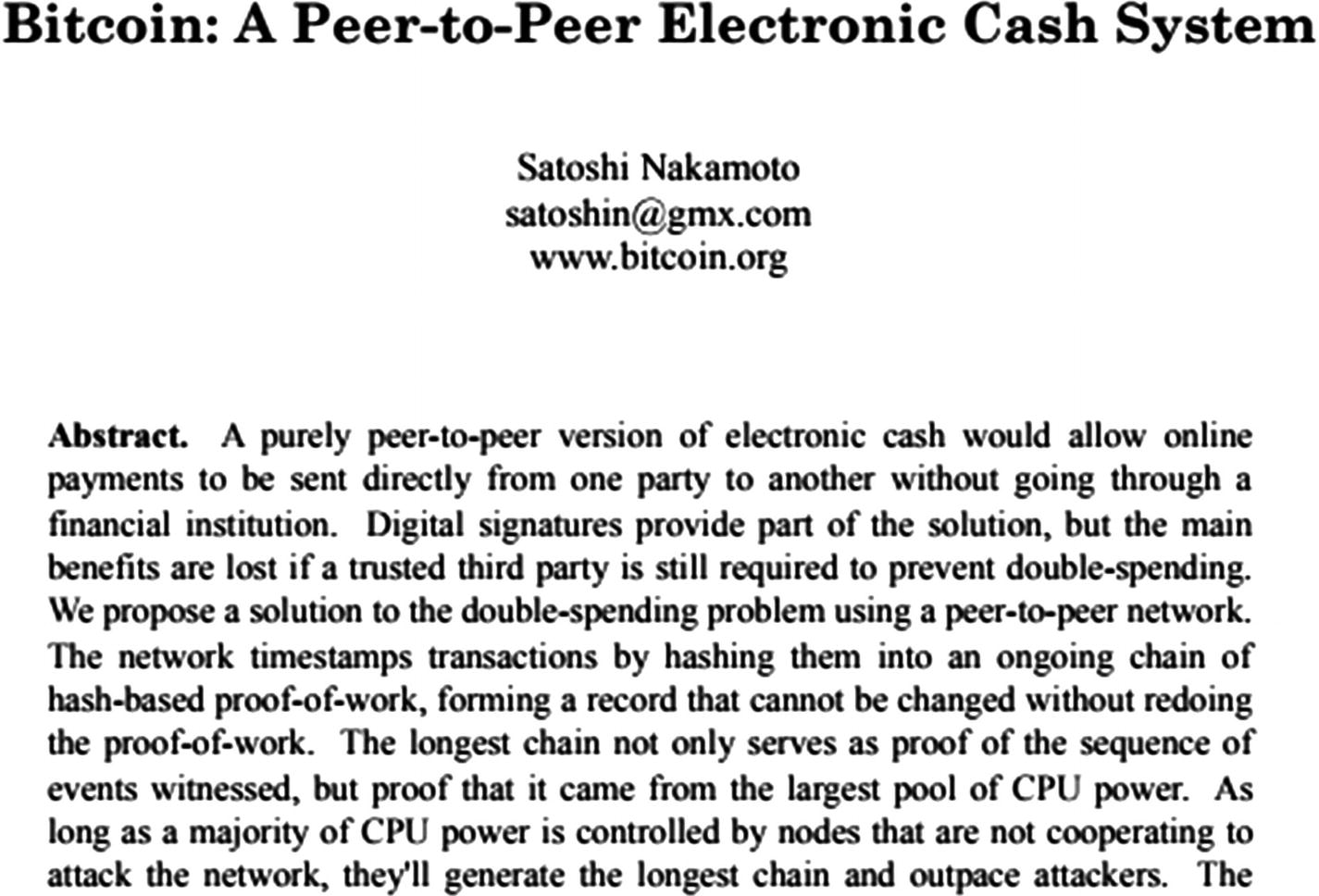
A snapshot of the Satoshi Nakamoto paper, through which Bitcoin and Blockchain emerged
Resolving the double spending issue through the use of a peer-to-peer network.
Ensuring participants identity can be hidden and they can be anonymous.
No requirement of trusted parties. In fact, you don’t need to trust any one but the system.
New coins of cryptocurrency can be generated through hash cryptography proof of work.
Tip
Although we have tried to give you a good overview of the paper, we still suggest you take some time and go through the actual paper written by Nakamoto. This paper is around nine pages long and is available at https://bitcoin.org/bitcoin.pdf .

The actual Bitcoin currency, which is another form of Bitcoin
Thank you, Satoshi Nakamoto! Bitcoin, among others, is now a real alternative to banking dominance. While writing this book, there were around 1400+ cryptocurrencies in the market, with Bitcoin being the oldest one.
What Is Bitcoin?

Each of the words marked in bold in this definition is very important. We are going to discuss in more detail each one, but for now just understand that Bitcoin is a digital currency so it doesn’t have a physical form. Unlike other digital cash, it has its own value and has corresponding denomination value for other currencies.
There is a lot of discussion about Bitcoin being trustless and anonymous. This is not correct. In fact, trust is the main issue that led to the emergence of cryptocurrencies like Bitcoin. What Bitcoin and other cryptocurrencies have done is ensure that trust is moved from centralized to decentralized systems. Even Bitcoin is a FIAT currency in nature, which means it is not backed by tangible value, but rather intangible value, i.e., trust. It has value just because a member of the group believes it has value and Bitcoin should be used to exchange in lieu of a good just like any currency. The only difference is a normal currency’s trust comes from government backing. Out here, it is from the people.
Bitcoin, being decentralized, is very secure in nature. The Bitcoin system can’t be faked. The system can be trusted with full transparency. In fact, identities in Bitcoin are hidden and each identity is referenced through alphanumeric codes done using hash cryptography rather than names.
The Blockchain is the underlying technology behind Bitcoin. Bitcoin is just an application created using Blockchain. Before delving more into Blockchain, it is important to understand the difference between centralized, decentralized, and distributed systems.
Centralized Systems
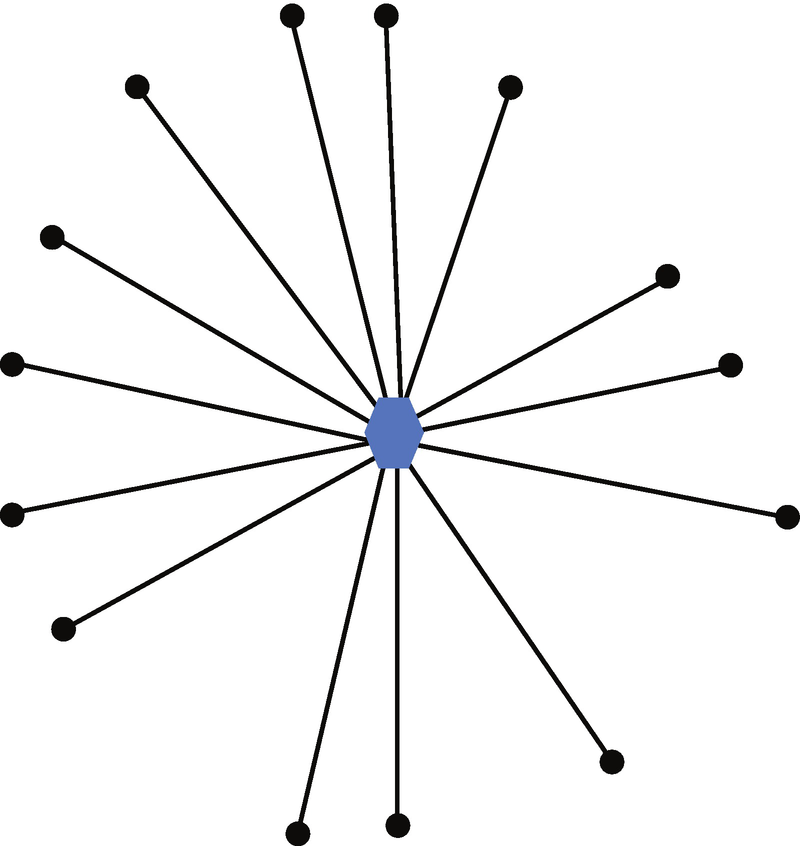
A pictorial representation of a centralized system , where one node governs the other nodes
The centralized system introduces a lot of advantages and hence it’s been popular even now. However, centralized systems also have a lot of flaws. A single POA brings the notion of having a single point of failure. This means if this point goes down for any reason, the entire system will collapse. We witnessed such failure during the financial crisis of 2008. Another flaw with these systems is that centralized system lacks transparency and is prone to fraud and distrust. Centralized systems works like a black box and people using centralized systems might get influenced with fraud and loss of trust. A centralized system has a lot advantages and are more suited for systems that can accept a single point of trust, require fast growth, and of course, don’t require growing systems at scale.
Decentralized Systems

A pictorial representation of classic decentralized systems
Decentralized systems are advantageous when you want to make a decision closer to the consumer rather than doing this at one central location. Some of the classic examples of decentralized systems include a Cloud database and state authorities, to name a few. One of the disadvantages of the decentralized system is that, since there is multiple points of authority, chances of a duplicate task is higher, which can affect economies of scale. A decentralized system is more secure than a centralized one, but is still not 100% secure.
Distributed Systems

A pictorial representation of distributed systems , where all nodes have equal power
The distributed system ensures a flat hierarchy, which ensures everyone is equal. There are a lot of advantages to having distributed systems. Since all the nodes are equal, it removes the need for an intermediary. Changes are replicated across all nodes and verified by at least 50 percent of the nodes, making it very transparent. Distributed systems make perfect options for a system requiring third-party trust, intermediary, or even trusting another node. While using the distributed system, you don’t need to trust anyone but the system itself. Some of the examples of distributed systems include cryptocurrency and of course, Blockchain.
With decentralization and disintermediation at the core of the Bitcoin system and Blockchain, there is no requirement for people to trust each other, just the system. Distributed systems , however, take some time to set up and require a good initial amount of investment. Among all the three systems, distributed systems are the most stable. Another benefit of using distributed systems is that they are infinitely scalable and hence any process involving scalability issues at large scale can safely vouch for using distributed systems.
What Is Blockchain?

Blockchain is far bigger than Bitcoin and Bitcoin is just one implementation of Blockchain

A classic ledger
Think about your transaction records kept in the bank. If someone has access to the central database, a person can modify and hack the records. Such hacking has happened to many banks and customers have suffered.
Take another case of you going to buy a property. How are you going to do a valuation of the property and ensure that it belongs to the person from whom you are buying it? Property information can easily be tampered with, making you pay more than it’s worth.
Take another use case of identifying organic vegetables from non-organic one. It would be hard to just trust those labels, which can easily be stamped on.
Take another case of leasing a car for a couple of years. How do you ensure that car is insured and within regulations for that country for driving?
Take another case of buying products from sites like Amazon and relying on them that they would deliver the authentic item you choose from the site.
You are also showing trust on email exchange providers while exchanging emails, on social networking site while doing social tasks, and so on.
These examples are cases where people have a greater level of trust. Moreover, due to digital technologies, we create copies of that data while sharing it. When one of your colleagues asks you to send an important spreadsheet via email, for example, you are sending a copy of the spreadsheet to him over email. This results in creating multiple copies of the important sheet. We keep on creating multiple copies of the same data, creating different owners. Trusting one of those copies as an original is a great challenge, as anyone who has ownership has the opportunity to modify any of the cells and then claim that it’s the original.
The rationale of trust is more important in the IoT era. As we have seen in previous chapters, more and more devices are getting connected and emitting data. It is important to ensure that data coming from these devices can be trusted. For all these use cases and many more, you can identify that the current system is either caged with a lot of paperwork, creating multiple copies, stored in the central custody of some third-party trusted source, either in the hard or soft copy. These ledgers can easily be modified and even faked.

Blockchain evolving to change the way we trust and getting it applied to various verticals
- Blockchain is distributed and decentralized in nature. Every computer that joins the Blockchain network, as shown in Figure 7-11, gets a copy of Blockchain immediately. These computer nodes are then used to validate and relay transactions.
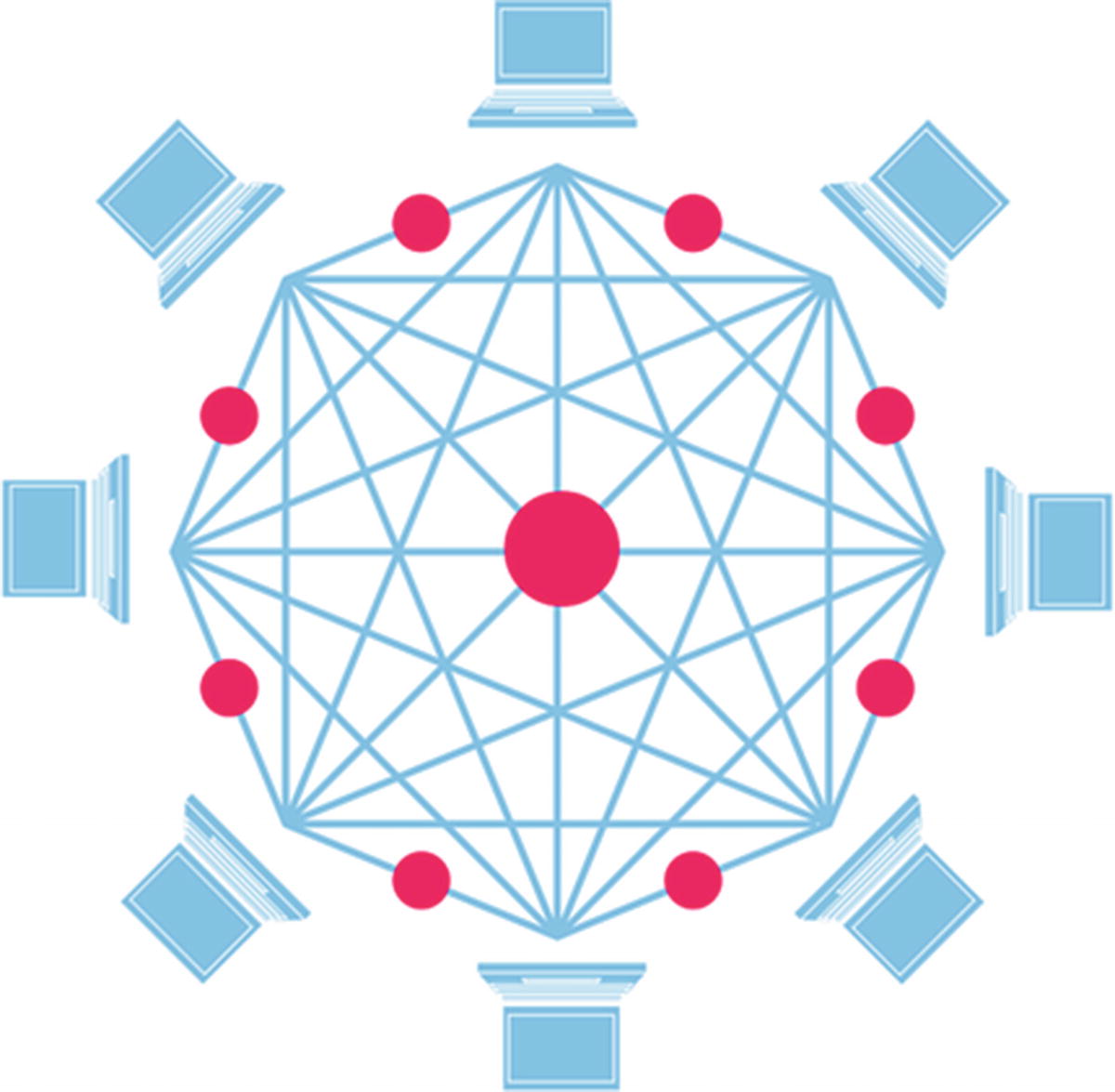 Figure 7-11
Figure 7-11All computer nodes joining the Blockchain network have equal writes and get a copy of Blockchain software immediately as they join network
- The Blockchain, as shown in Figure 7-12, is immutable in nature. This means the Blockchain transaction cannot be edited or deleted. If you want to modify or undo a transaction, you must propose new transactions, which go through the same process of approval. Only when the majority of nodes approve it will it be accepted.
 Figure 7-12
Figure 7-12The Blockchain network is very secure and immutable
Blockchain is fully secure in nature as it uses hash cryptography for handling identities.
Every record added to the Blockchain ledger has a unique key associated with it.
Every record added is trusted and stamped by the party that added that record.
When the next record is written, everything from the first record including the key and the content of the second record is put in the formula, generating the key for the second record.
In a one-liner, Blockchain is an immutable distributed ledger that can be used to record everything of value. This statement provides the true testimony to the usage of the Blockchain. Most of the use of Blockchain until now has been associated with financial transactions, but eventually, Blockchain can be used to record and manage anything that has value.
Blockchain technology delivers unbelievable traceability that is autonomous and trusted by creating permanent records of data and transactions. It thereby brings the single source of truth and no single point of failure to all stakeholders, as everything related to data and transactions are always visible on the network.
What Is a Block?
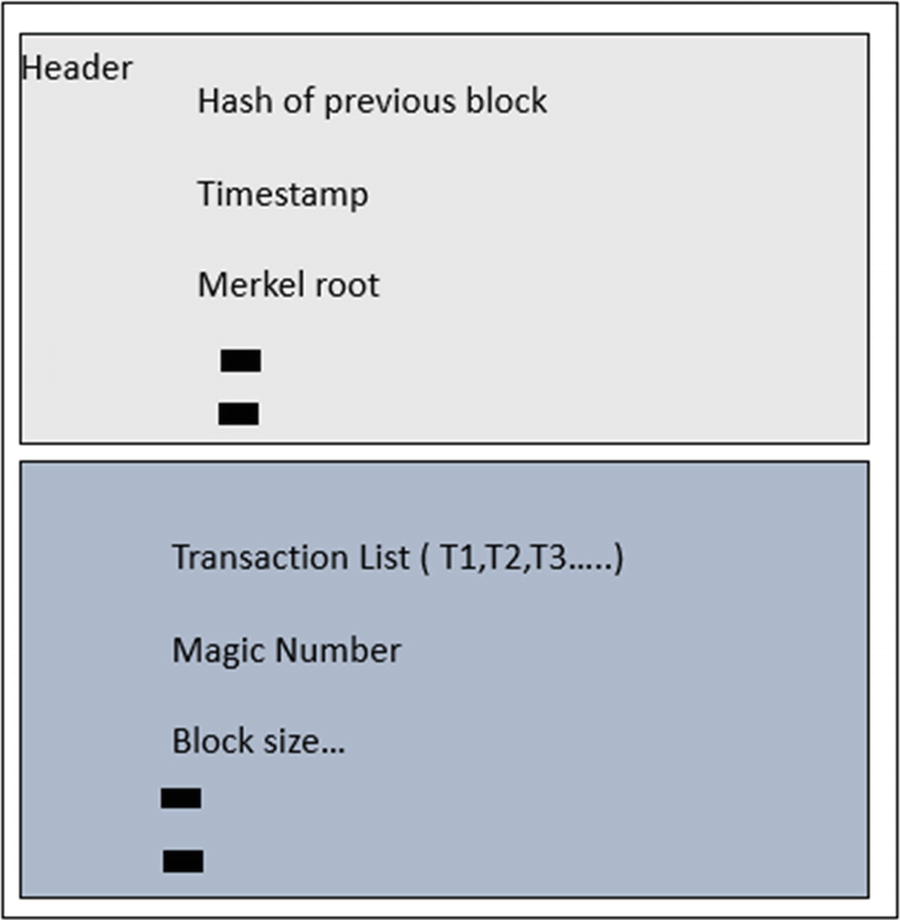
The items available in a block of a Blockchain

The classic representation of Blockchain
Benefits of Blockchain
Improves the efficiency of the system.
All the changes on the public Blockchain can be viewed publicly by all parties, thereby creating transparent systems.
Ensures transactions are immutable in nature, which means transactions cannot be altered or deleted. In order to modify existing transactions, the new transaction needs to be proposed.
Blockchain transaction is processed 24/7 and can also help reduce transaction time to minutes.
Provides a secured way to avoid cybersecurity and fraud risk by using trust secured algorithms.
By eliminating third-party intermediaries and overhead cost, Blockchain has great potential to reduce transaction feeds.
Provides alternate options of trust using centralized systems.
Provides ways for identification and verification.
If you think about it a bit, you might agree that Blockchain is a great way to store and organize data without the need for trusted authority.
Smart Contracts
Smart Contracts are self-executing contracts. They are also known as digital contracts. Smart Contracts are not a new concept. In fact, two decades back, Nick Szabo, a computer scientist, proposed and emphasized the need for the Smart Contract while designing and implementing the decentralized based system.
The Smart Contract can be treated as a computer program that helps in executing contracts digitally. Unlike any other contract, Smart Contracts don’t just define instructions and consequences around an agreement, but also enforce them. With the use of Smart Contracts, computers can take an action if some requirements get fulfilled. In raw terms, Smart Contracts are a suite of various if-else statements. Take a betting scenario case. If Real Madrid wins the La Liga, Nishith gets the money; otherwise, he pays.
In most cases, you might not trust the other party during the betting. In these scenarios, self-executing contracts bring a lot of trust on the table. Smart Contracts also bring options to revise, execute, or even propose contracts, thereby ensuring the highest level of traceability and trust. Take a use case of insurance claims. Currently, all insurance companies use the manual process of paperwork, complex execution, administration costs, etc. It would indeed be beneficial to execute these claims using Smart Contracts to ensure a hassle-free claiming process, less administration cost, and the highest level of transparency. Take another case of payment where you pay to the contractors only when they fulfills your requirement. Smart Contracts and Blockchain can be used to remove a lot of inefficiencies that exist in the contracts management process.
Ethereum

The Ethereum coin
Ethereum is a shared computing platform that enables people to build smart contracts and cryptocurrencies without having people to build their own Blockchain. On top of that, it has its own Turing complete programming language that allows developers to create custom applications. Ethereum is a game changer in Blockchain implementation, as it allows everyone to adopt the Blockchain technology.
Types of Blockchain
Public Blockchain : The original form of how Blockchain was coined. Anyone from the public can join the network, write the data under the consensus protocol, and read it. The advantage of this Blockchain type lies in being fully decentralized, transparent, and anonymous. These types of public Blockchains are applicable across various cryptocurrencies, including Bitcoin, Ethereum, litecoin, etc.
Private Blockchain : Also known as internal Blockchain, this type of Blockchain implementation is designed for private networks and governed by one organization. This organization is responsible for setting up the rules to join the network and read data. Some of the trusted nodes get the higher privilege of providing acceptance of the transaction. Such types of Blockchain implementation are less expensive, faster, confidential, and only allow authenticated parties to participate in the network. Some of the examples are the Kadena chain, Iroha, and Blockchain implemented by organization internally for their processes.
Hybrid Blockchain : Hybrid Blockchain is a combination of public and private Blockchain so it is a partly private, permissioned Blockchain. These types of Blockchain implementations are owned by a group of companies, forming a consortium. Such a Blockchain is efficiently used for working in a shared platform. These Blockchains only allow specific parties or nodes to be part of the Blockchain, participating in the transaction. Some of the examples include R3 Corda, Multichain, etc.
Recap
In this chapter, you learned about the history of various exchange mediums and the need of cryptocurrency. You also got a good understanding of how Bitcoin is different from Blockchain. Later in the chapter, you learned about the various types of systems (centralized, decentralized, and distributed) and learned why distributed systems are the most secure ones. The latter part of the chapter introduced you to the need for smart contracts and Ethereum. At the end of the chapter, you learned about various types of Blockchain implementation currently available. In the next chapter, we start working on the development of Blockchain and applying it to the hospital use case.
